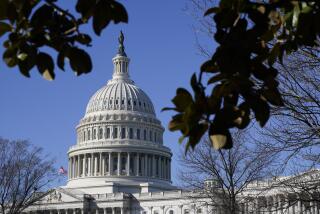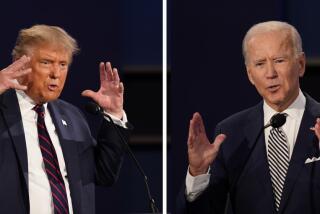Shape of things to come: Ad wars over Medicare heat up
The battle over Medicare and the federal budget has been joined unusually early by independent political groups, providing an indication of the large role they are likely to play in the 2012 campaign and beyond.
Just last week, groups on the left and the right spent close to $1 million on broadcast ads in three dozen swing congressional districts. All of the ads focused on the Republican proposal to reduce the federal deficit by narrowing the government’s commitment to pay for seniors’ healthcare under Medicare; the GOP plan would also reduce federal spending on Medicaid, which primarily serves the poor and needy seniors receiving long-term care.
So far, the bulk of the spending to defend the budget proposals, drafted by Rep. Paul Ryan (R-Wisc.) and strongly endorsed by House Republicans, has come from 60 Plus, a conservative non-profit group which has spent $800,000 in recent days.
“Our Congressman, Allen West, voted to protect Medicare and keep it secure for future retirees,” said one radio ad running in West’s Florida district, one of the 39 districts targeted by the 60 Plus campaign.
The organization, which can solicit and spend unlimited sums because it is not part of either political party or a specific candidate’s campaign operations, is not required to identify contributors.
It spent more than $7 million in the 2010 election cycle, backing Republican candidates on a range of conservative issues. Now, 60 Plus has launched a radio, telephone call and direct mail campaign praising Republicans who voted for the Ryan budget.
A variety of groups on the left are also up on the airwaves, some for the first time. One Democratic-leaning independent group, the House Majority PAC, released a radio ad last week targeting freshman Rep. Sean Duffy (R-Wisc) for embracing the GOP budget.
“While Duffy’s budget leaves the wealthy fat and happy, it puts the squeeze on Wisconsin families, and will end Medicare as we know it. That’s right, end Medicare as we know it,” the ad said.
The Ryan budget, the primary goal of which is to reduce the federal deficit, would give seniors a fixed amount of money to spend on private health insurance instead of paying for all covered medical expenses as the present plan does. Current Medicare recipients would be exempted from the change, but in future Ryan’s plan would require the average senior to pay some $6,000 a year more in out-of-pocket expenses, according to the non-partisan Congressional Budget Office.
Federal funding for Medicaid would become a block-grant program.
Republicans argue that curbing federal spending on healthcare is critical to preventing runaway deficits that could destroy the programs and damage the whole U.S. economy.
Democrats argue that healthcare costs can be reduced and the deficit shrunk through government efforts, including the new healthcare law.
The Democratic-leaning House Majority PAC filed papers with the Federal Election Commission, courted donors and spent $115,000 on targeted ads in 10 congressional districts, including Duffy’s — all within nine days. That breakneck speed is illustrative of the more aggressive tilt Democratic independent groups are taking in 2012.
“Progressive groups were outspent three-to one in House races in 2010,” said Alixandria Lapp, the group’s executive director. “Our goal is to not let that happen again. That’s why we’re up so early.”
By contrast, during last year’s congressional campaign, America’s Family First, a predecessor to Lapp’s group, did not begin spending until just a month before the balloting that gave Republicans control of the House.
Well-funded conservative oriented groups had been advertising in key House districts through the summer.
The Democratic-leaning groups’ new energy comes partly from what Lapp and others see as a favorable climate for Democrats because of public concern about the Republican proposals. Confidence also springs from the warm reception the new organizations have received from donors.
Earlier this month, Lapp was among several officials from new groups on the left that made a presentation to about 100 potential liberal donors at a meeting in Laguna Beach organized by the Democracy Alliance, which vets activist groups on behalf of prospective millionaire donors, according to one participant.
Other new organizations, including one founded by two former White House aides, Sean Sweeney and Bill Burton, also made presentations at the event.
Jim Jordan, a veteran Democratic strategist, said his newly-launched independent expenditure committee, dedicated to electing Democrats to the Senate, will similarly be an early and vocal political presence.
“We’ll be opportunistic and aggressive, even in the out-year,” Jordan said of his group, Majority PAC. Majority PAC and House Majority PAC are both organized as “super PACs,” independent expenditure committees that can raise unlimited amounts of money from contributors whose donations are reported to the Federal Election Commission.
But the Senate group is affiliated with a nonprofit 501(c)(4) social welfare group that can raise money from undisclosed donors and give money directly to super PACs.
Another liberal group, Americans United for Change, a 501c(4), ran ads denouncing the Ryan plan on cable news in the lead-up to the budget vote. Last week it unveiled a new week-long campaign, worth $35,000, targeting four Republican districts including Ryan’s.
“We thought it was a wise use of resources to kill something in the cradle right at the beginning, as opposed to waiting two weeks before the election,” said the group’s spokesman, Jeremy Funk.
The national party committees also jumped into the Ryan budget fray. But their first round of radio ads and robocalls were funded with relatively paltry sums—less than $50,000 -- spent by the Democratic Congressional Campaign Committee and the National Republican Congressional Committee, respectively.
In contrast, the spending from both 60 Plus and Majority PAC greatly outpaced the party committees, signaling the outside groups will be the dominant message drivers and are, at this stage, superceding the party in influence.
No doubt, these early buys will be dwarfed in the larger sweep of independent electoral money. In the 2010 cycle, outside conservative groups spent more than $190 million and liberal groups spent more than $95 million, according to the Center for Responsive Politics.
“There’s not move-the-needle type dollars being spent” at this point, said campaign media expert Evan Tracey. Still, Tracey said, these initial efforts are a sign of the impending deluge.
“It’s coming,” he said. “This will be part of the long run up to 2012.”







